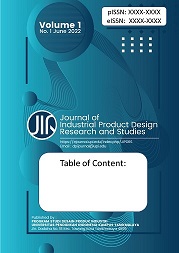King Palm Frond Development as Fashion Product using Modular Interlocking System
Abstract
Keywords
Full Text:
PDFReferences
Cochran, W. G. (1957). Analysis of covariance: Its nature and uses. Biometrics, 13(3), 261-281.
Dharmawan, Maureen F. (2015). Pemanfaatan material alam pelepah palem menjadi bahan benda produk. Jurnal Ilmiah Mahasiswa Universitas Surabaya, 4(1), 1-19.
Haq, K., and Rosandini, M. (2016). Eksplorasi teknik tessellation dan interlocking modular untuk produk fashion. eProceedings of Art & Design, 3(2).
Lasarus, R. (2018). Analisis sifat mekanik serat kulit kayu khombuow dan serbuk bambu dengan metode uji tarik. In Neutrino 1(2), 13-17.
Manik, P., Eko Sasmita Hadi and Dedi Cristianto. (2004). Kajian teknik penggunaan serat bambu sebagai bahan komposit pembuatan kulit kapal. Laporan Penelitian Dosen Muda, dikti. 28(1), 66-70.
Nur, Christmastuti. (2017). An alternative of eco-friendly material from banana peduncle waste. Proceeding of 1st Icon-Arcade, 5(6), 212-220.
Puspita, R., Handayani, R. B., and Gondoputranto, O. (2020). Perancangan aksesoris tas dengan upcycle limbah banner menggunakan teknik interlocking modular untuk brand nocturne. Moda: The Fashion Journal, 2(2), 106-121.
Raghupathy, R., Viswanathan, R., and Devadas, C. T. (2002). Quality of paper boards from arecanut leaf sheath. Bioresource Technology, 82(1), 99-100.
Tjahjono, S,. (1997). Pengaruh serat nabati dan fraksi volume serat terhadap sifat mekanik material komposit. Jurnal TS Surabaya, 1(1), 177-187.
Yernisa, E Gumbira-Said and K Syamsu. (2013). Aplikasi pewarna bubuk alami dari biji pinang (Areca Catechu L.) pada pewarnaan sabun transparan. Jurnal Teknologi Industri Pertanian, 23(3), 190-198.
DOI: https://doi.org/10.17509/jipdrs.v1i2.52614
Refbacks
- There are currently no refbacks.
Copyright (c) 2022 Universitas Pendidikan Indonesia (UPI)

This work is licensed under a Creative Commons Attribution-ShareAlike 4.0 International License.

This work is licensed under a Creative Commons Attribution-ShareAlike 4.0 International License.


